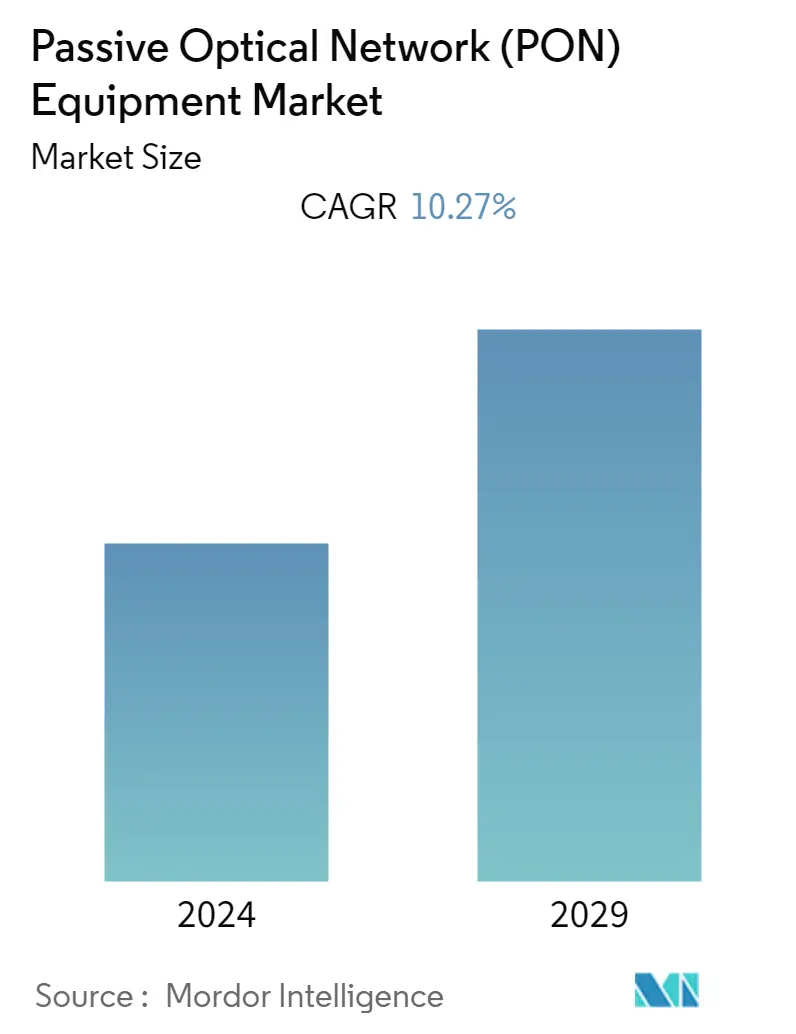Market Size of Passive Optical Network (PON) Equipment Industry

| Study Period | 2019 - 2029 |
| Base Year For Estimation | 2023 |
| CAGR | 10.27 % |
| Fastest Growing Market | Asia Pacific |
| Largest Market | North America |
| Market Concentration | Medium |
Major Players-equipment-market/passive-optical-network-(pon)-equipment-market_1591159407616_MP_Passive_Optic_Network_(PON)_Equipment_Market.webp)
*Disclaimer: Major Players sorted in no particular order |
Need a report that reflects how COVID-19 has impacted this market and its growth?
Passive Optical Network (PON) Market Analysis
The Passive Optical Network (PON) Equipment Market is expected to grow at a CAGR of 10.27% over the forecast period. In recent years, the penetration of LTE networks and fixed broadband subscription rapidly grew and is expected to follow the trend in the forecast period. Also, the Ericsson mobility report mentioned the fixed broadband connection is expected to grow steadily by 3% year-on-year till 2024, which is expected to drive the PON equipment market growth.
- Additionally, governments are taking initiatives like smart city programs with fiber optic-rich networks to enable the smooth flow of IoT infrastructure. Fiber optic network allows the technology to drive utilities like water, electricity, wastewater, sewerage management, security, and communication. According to the UN, over 68% of the global population is estimated to live in urban areas by 2050, which will fuel more smart city projects globally.
- The demand for networks with greater capacity is increasing as data traffic keeps growing exponentially. Because they can deliver high bandwidths across great distances, passive optical networks (PONs) present a viable solution to this issue. The rising need for bandwidth is the primary factor driving the passive optical network market growth. Consumers demand faster and more dependable networks as video streaming and other bandwidth-intensive apps proliferate. Due to their ability to deliver gigabit speeds over considerable distances without the use of active components or pricey optical fiber, PONs are uniquely suited to meet this demand.
- Due to the COVID-19 outbreak, countries worldwide implemented preventive measures. While schools were closed and communities were asked to stay at home, many organizations were finding ways to enable employees to work from their homes. Telecom companies actively made efforts to build full-fiber infrastructure to deliver an ultrafast, ultra-reliable, and futureproof broadband network.
- For instance, the average monthly mobile user in China's online traffic increased from 7.8 GB to 14.9 GB over the past three years, driven by 5G, according to data released at the global 5g convention. It facilitated remote work, online education, digital life, scientific research, and epidemic prevention and control during the COVID-19 pandemic. These factors significantly contribute to the market growth rate during the forecast period.
